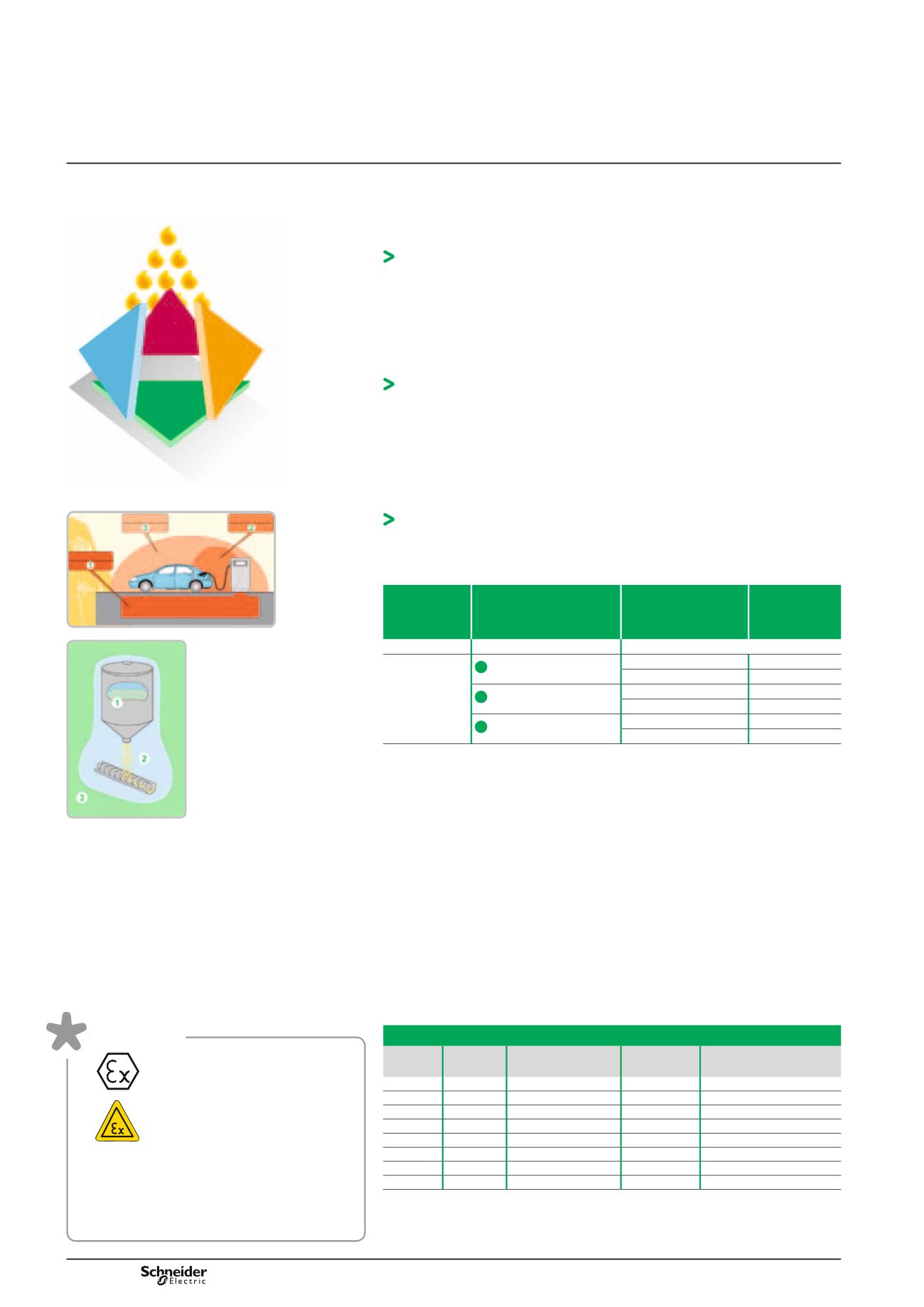

396
PB500061-26
PB500060-47
PB500059-52
ATEXenclosures
Enclosures for explosive
atmospheres
Introduction
Potentially explosive atmospheres:
important information
Equipment for potentially
explosive atmospheres
b
b
Since 1st July 2003, European directive ATEX 94/9/CE has made it compulsory
to use certified electric or non-electric equipment when it must be installed in zones
with explosive atmospheres (gas or dust).
b
b
Certification must be provided by a body which is notified according to the same
directive.
b
b
The body notifies its assessment of the quality of the production and certifies that
the product complies with the health and safety demands defined in the directive
and the international standards.
b
b
The certificate shows the category of the product by marking, and thus the zone
and atmosphere in which it can be used.
b
b
The standards define the following types of protection for electric equipment:
b
b
Enclosures are certified as components. They will be assembled with other ATEX
electrical, pneumatic and hydraulic components, among others to form a final solution
which, in turn, must be ATEX-certified and subject to a declaration of conformity.
Electrical equipment
CENELEC IEC
Gas: symbol of the
types wof protection
CENELEC/IEC Powder: symbol of the types
of protection
EN 60079-0 IEC 60079-0 General rules
IEC/EN 61241-0 General rules
EN 50015 IEC 60079-6
0
-oil immersion
IEC/EN 61241-1
tD
-protection by enclosures
EN 50016 IEC 60079-2
p
-pressurised enclosures IEC/EN 61241-4
pD
-protection by pressurisation
EN 50017 IEC 60079-5
q
-powder filling
IEC/EN 61241-11
iD
-protection by intrinsic safety
EN 60079-1 IEC 60079-1
d
-flameproof enclosures IEC/EN 61241-18
mD
-protection by encapsulation
EN 60079-7 IEC 60079-7
e
-increased safety
EN 50020 IEC 60079-11
i
-intrinsic safety
EN 60079-15 IEC 60079-15
n
-type of protection "n"
Zone 2
Heat
Chain
reaction
Fuel
Explosive atmosphere
Oxygen
Zone 0
Zone 20
Zone 22
Zone 21
Zone 1
Definition
Product directive 94/9/CE:
defines the manufacturers' obligations.
Personal protection directive 99/92/CE:
defines the users' obligations.
Degree of protection:
In hazardous areas, equipment is required to offer a
minimum degree of protection of IP54, but it can be
tested or certified with a higher degree of protection.
b
b
It is a term commonly used to describe potentially EXplosive ATmospheres
and standards for protection systems and equipment.
b
b
Two European directives, ATEX 99/92/CE and ATEX 94/9/CE, and international
standards IEC 60079 and IEC 61241, harmonized with EN European standards,
apply to this field.
What is ATEX?
Destination Categories/presence
of potentially
explosive atmosphere
Hazardous zones Atmosphere
Group I Mines M1 and M2
Gas and dust (G & D)
Group II
surface
Industries
1
Permanent or frequent
Zone 0:
gas and vapour G
Zone 20:
mist and dust
D
2
Occasional
Zone 1:
gas and vapour G
Zone 21:
mist and dust
D
3
Rare
Zone 2:
gas and vapour G
Zone 22:
mist and dust
D
b
b
They are classified into groups and zones according to directive 99/92/CE
and IEC standards as follows:
Classification of an explosive atmosphere
b
b
An potentially explosive atmosphere is defined as a mix of flammable substances
in the form of gas, vapour, dust (cloud or deposit) which, in air and under normal
atmospheric conditions, can completely or partially catch fire in the form of an
explosion when exposed to a source of ignition.
How is a potentially explosive atmosphere defined
according to ATEX?


















